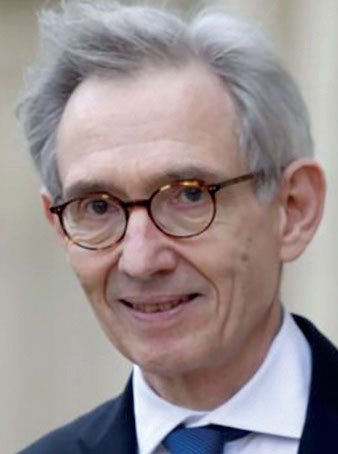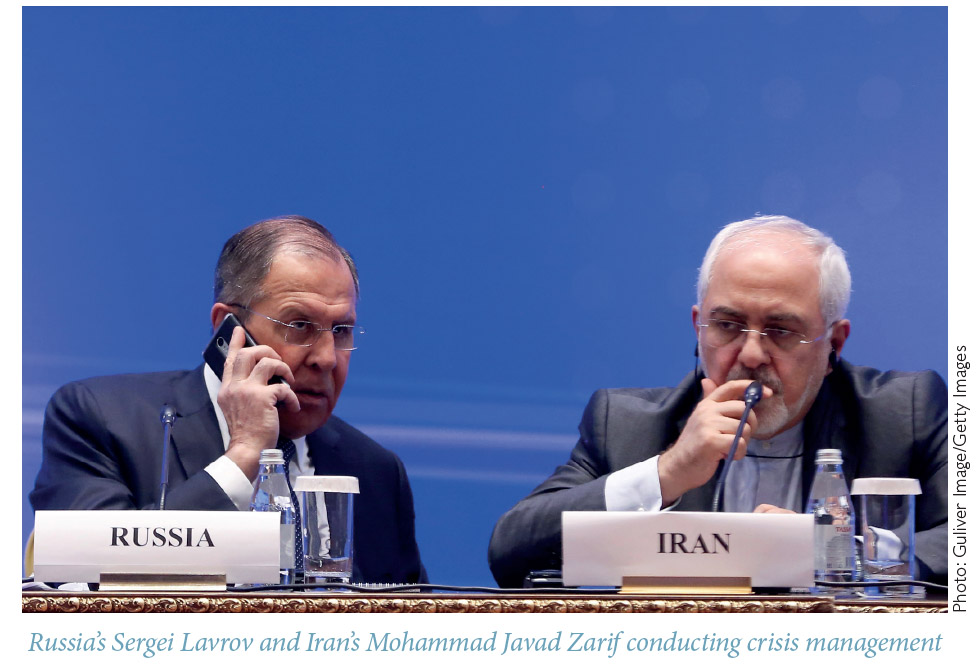
 Michel Duclos is Special Advisor to the Institut Montaigne, a Non-resident Fellow at the Atlantic Council, and a former Ambassador of France to Syria. You may follow him on Twitter @MrjDuclos. Andrey Kortunov is Director General of the Russian International Affairs Council (RIAC) and President of the New Development Technologies Autonomous Non-profit Organization. This essay is a revised version of a blog post that originally appeared on the website of the Institut Montaigne.
Michel Duclos is Special Advisor to the Institut Montaigne, a Non-resident Fellow at the Atlantic Council, and a former Ambassador of France to Syria. You may follow him on Twitter @MrjDuclos. Andrey Kortunov is Director General of the Russian International Affairs Council (RIAC) and President of the New Development Technologies Autonomous Non-profit Organization. This essay is a revised version of a blog post that originally appeared on the website of the Institut Montaigne.
We start by turning our attention to the beginning of 2020, which was marked by yet another major crisis in the Middle East region, instead of focusing on the more recent onset of the COVID-19 pandemic—the consequences of which only serve to reiterate the veracity of the argument put forward in what follows.
The crisis in question culminated with the American elimination of Major-General Qasem Soleimani, the commander of the Quds Force of Iran’s Islamic Revolutionary Guard Corps. This crisis could have slipped towards direct military confrontation between the U.S. and Iran—with unpredictable consequences not just for the MENA region but also for the international system at large—had the Iranian retaliatory strikes on U.S. military bases in Iraq not paused the escalation of tensions.
However, one should not be under any illusion: if there is a pause, it can be only temporary.
As events unfolded, U.S.-Iran tensions crystallized over the political situation in Iraq. There, their struggle for influence seemed to tilt in Iran’s favor as the Iraqi Parliament voted in favor of a resolution demanding the withdrawal of American forces; Tehran appeared to be in a position to redirect the anger of the Iraqi population away from their discontent with the Baghdad government to an anti-American feeling.
A few hours—and the tragic accidental downing of the Ukrainian plane near Tehran’s airport—were enough to bring about another reversal of the overall picture: calls for “Iranians out” soon accompanied shouts for “Americans out” that were heard being exclaimed by protesters in Baghdad’s Tahir Square.

Meanwhile, Iranian citizens started taking to the streets again in Tehran and elsewhere, despite the massive crackdown on the last protests that had taken place months before in order to denounce the incompetence of the Islamic Revolutionary Guard—going so far as to question the role of the Supreme Leader himself.
Increasing Volatility
Drawing from these and recalling events a little further back, it seems evident to us that observers and decisionmakers can no longer restrict their analyses to traditional geopolitical dynamics. Instead, they have to acknowledge popular unrest dynamics at work in a number of countries including Lebanon, Iraq, and Iran. Regional governments would delude themselves if they were to believe that popular unrests are exclusively the product of foreign interferences. Reactions to the COVID-19 outbreak in these and neighboring states have made this point more salient.
This new factor adds another element of uncertainty to the unstable balance of power in the region. One should also keep in mind the very particular situation of the two main players.
The general assumption is that President Trump “doesn’t want a war.” That’s likely, as much as it is obvious that his priority is to withdraw American troops as quickly as possible from the Middle East and the broader region, including Afghanistan. These assumptions feed the general perception in Gulf countries that the American security guarantee is much weaker than it used to be.
Having said that, nobody can predict how America’s 2020 presidential campaign, especially if his response to the COVID-19 pandemic comes to be perceived as insufficiently effective, is going to influence Donald Trump’s actions in the run up to the vote in November. The incumbent U.S. presidential candidate is torn between his willingness to “end endless wars” and the need for him to show he is not an Obama-like appeaser.
An additional complication comes from the fact that Iran has virtually left the nuclear agreement (JCPOA) while the current UN embargo on conventional weapons to Iran is due to expire in October of 2020 and that there is practically no chance for it to be extended by the UN Security Council. These developments reinforce the perception that Trump’s strategy of maximum pressure has led nowhere.
On the Iranian side, the leadership of the country is facing grave difficulties: the dreadful state of the economy, the unprecedented challenge to the legitimacy of the system, and the loss of Islamic Republic’s biggest source of influence in the region General Soleimani. Resuming the nuclear program will do nothing but further isolate the country from the international community, including losing the already lukewarm support of Russia and China.
Not the Time for Collective Security
Although both sides turned out to be cautious enough to avoid direct confrontation in January, none of the fundamental problems between Washington and Tehran has been resolved. Moreover, one may fear that the January 2020 crisis destroyed all hopes of a substantive U.S.-Iranian dialogue finally taking off and of an agreement on some compromise version of the “Macron oil plan” being signed.
While Trump did reconfirm his readiness to meet with Iranian leaders with no strings attached, he also imposed additional sanctions on key sectors of the Iranian economy. Predictably, the Iranian side rejected the American offer, arguing that no dialogue is possible without American sanctions being lifted or, at least eased. Tehran also reserved its right to respond to future “U.S. provocation” with any means it considers appropriate.
One can only hope that channels of communications between the two states will survive the January 2020 crisis and continue to operate until the November 2020 elections in the United States. The question is whether these channels will be sufficient to handle another crisis.
Is there any trust left between the American and Iranian militaries? Or, for that matter, between their respective intelligence services? What about another impulsive decision by U.S. President Trump, or another human error, or a technical failure? What about likely irresponsible actions by autonomous non-state actors that could trigger the chain-reaction leading to a large scale Middle East war?
There are a number of reasons why the risks of an inadvertent escalation seem to be particularly high in the MENA region.
First, most of the political regimes in that part of the world combine weak institutions with centralized personal power, which makes the decisionmaking process quite dependent on personal perceptions and misperceptions, as well as emotions and improvisation.
Second, regional escalation can be not only vertical, but also horizontal, involving many hotspots at the same time: for instance, escalation might take place simultaneously in Yemen, the Strait of Hormuz, Syria, Lebanon, Iraq, and so on.
Third, this escalation can result from unauthorized actions by proxies and “loose cannons,” which remain abundant in the region.
Fourth, many leading regional players have in their possession not only the most sophisticated modern weapons (which they often fail to muster properly), but also substantial means of cyberwarfare able to inflict critical damage to the command, control, communications, and intelligence capabilities of their adversaries.
Fifth, as it has been noted, international escalation might emerge as a side effect of unforeseen domestic developments in one (or more) of the MENA countries, and it appears likely that such unforeseen developments will take place in the region in 2020 or later.
In those dire circumstances, the time is not ripe for big schemes for the future—in the form, for instance, of a collective security system. Nobody would argue against such a system and many roadmaps leading to various models of collective security have been put forward. However, moving toward this goal would be an extremely long, precarious, and bumpy road with very unclear prospects of getting to the final destination.
Even in Europe, it took fifteen years to move from the Helsinki Act of 1975 to the Paris Charter of 1990. Besides, the Paris Charter has never been implemented in full: today Europe is moving away from a collective security system, not towards it. There are absolutely no reasons to believe that one can successfully implement in the MENA region a model that failed in the most spectacular way in Europe.
First Step’s First
All that being said, it is clear that there is a more-than-ever a need for some sort of MENA-wide crisis management mechanism—one that is able to mitigate the potential consequences of new incidents, miscalculations, risks of escalation, and so on. The absence of such a mechanism is already a significant factor of instability since it constantly generates mistrust and raises suspicions about intentions of adversaries.
The immediate goal of establishing such a mechanism should not be to resolve all existing security problems within the region, but to provide for more predictability and mutual confidence in dealing with unavoidable micro-, mini-, and mega-crises that already loom over the horizon.
It is with all this in mind that we offer the following suggestions. First: Iran and the Arab states of the Gulf would gain from taking control over their security interests, at least in terms of crisis prevention and crisis management.
If one may think that a form of Iranian deterrence (as regards to the threat posed by Iran and its proxies) against American interests in the region has been partially “reestablished,” nothing has been done to enhance the security of the Gulf countries in the same way. They remain vulnerable, and the reaction of the White House to an attack on American interests remains unpredictable. At a time of acute tension with the United States—by far the strongest military force in the region—we would also suggest it is not in the interest of Iran to antagonize their immediate neighbors.
Second, a starting point in terms of “escalation risk control” should be to establish lines of communication and crisis cells able to exchange early warnings and information based on reliable technical monitoring instruments. Present realities being what they are, even such a limited aim would require courageous decisions. In this regard, maritime security in the Gulf could provide a potentially fruitful ground to explore the idea of such confidence-building measures.
All regional players share an interest in preserving freedom of passage in the Gulf. In that respect, it is noticeable that the Iranian HOPE project (Hormuz Peace Endeavor) has not been totally rejected by Gulf countries. However, while this diplomatic move by Tehran could indeed yield better bilateral relations between Iran and some of its neighbors, it does not necessarily guarantee progress in terms of multilateral dialogue. If rewarding for the Iranians, this is not the best way forward.
A coordinated approach by the GCC making a counter-offer on the basis of a limited crisis management mechanism specifically focused on maritime security in the Gulf (and taking off the table some Iranian proposals like those related to foreign military bases, which are not realistic for the time being) would be much more appropriate.
Such a mechanism would be somewhat similar to the pattern of interaction between NATO and the Warsaw Pact back in 1970s and 1980s. There are clear limitations on what this mechanism can do. For instance, it cannot become a viable alternative to legally-binding arms control.
It cannot address such fundamental problems as geography of deployments, defense-offence balances, evolution of military doctrines, and so on. Moreover, a crisis management mechanism can deter only an unintended (inadvertent) escalation; it cannot help in case of an intended (advertent) escalation. If one side of a conflict considers “strategic ambiguity” as its comparative advantage—or pursues such a strategy with the goal to “escalate in order to de-escalate”—no crisis management mechanism is likely to work.
In sum, no crisis management mechanism is a panacea for security challenges in the region. Still, one should not underestimate the utility of such a mechanism as the one presented in these pages, if the only alternative in the nearest future is the complete vacuum of de-escalation instruments that regional players could rely on in a time of crisis. Once this mechanism matures and trust among key actors gradually grows, one could get back to more proposals that are more ambitious, including collective security in the Middle East.
The role of External Players
While regional players should be in the lead, there is room for some external players to contribute as well. There is a manifest need for a “coalition of the willing” ready to come up with a consolidated position on this matter and to encourage its local partners to take first steps toward establishing a crisis management mechanism.
Such a coalition could for instance be based on the JCPOA “P5+1” format. Another and more creative format—given the current level of hostility between Washington and Tehran—could be a “EU3 +3” grouping (excluding the United States but adding India). The latter format could be instrumental to work on the basis of the Iranian HOPE project on the one hand and a counterproposal coming from the GCC on the other hand. If both Iran and Saudi Arabia were to join the endeavor launched by this potential EU3+3, a new entity or sorts could appear progressively—no love at first sight is to be expected—which could be labeled “P4+4” (China, France, Russia, the UK plus India, Iran, Germany, and Saudi Arabia).
Should the United States be excluded from such an endeavor? Of course not. On the contrary, American engagement should be welcomed, no matter when or if it wants to join. In the current situation, it is realistic to think that America’s regional allies will not go very far in this direction as long as there is no green light from the United States.
However, our point is that even without American engagement or explicit green light, Arab Gulf states have good reasons to at least engage in a preliminary discussion between themselves, and with external players, on those ideas. Furthermore, it would make sense from an American point of view to go along with a modest and specific step related to maritime security in the Strait of Hormuz.
More generally, one of the obvious lessons of the January 2020 crisis is that the United States is not at this stage either willing or capable of performing the role of the region’s unquestionable security provider. The challenge for regional and non-regional players alike is therefore not to impose this role on Washington, but rather to convince the United States to abstain from blocking any multilateral or bilateral de-escalation initiatives between Iran and its Arab neighbors.
However, one can hope that, at some point in the future, the United States will change its current skeptical attitude to multilateral security arrangements and can become an indispensable participant to the core of a crisis management mechanism in the MENA region. A seat at the table should be reserved for the United States no matter how long this seat remains empty.







